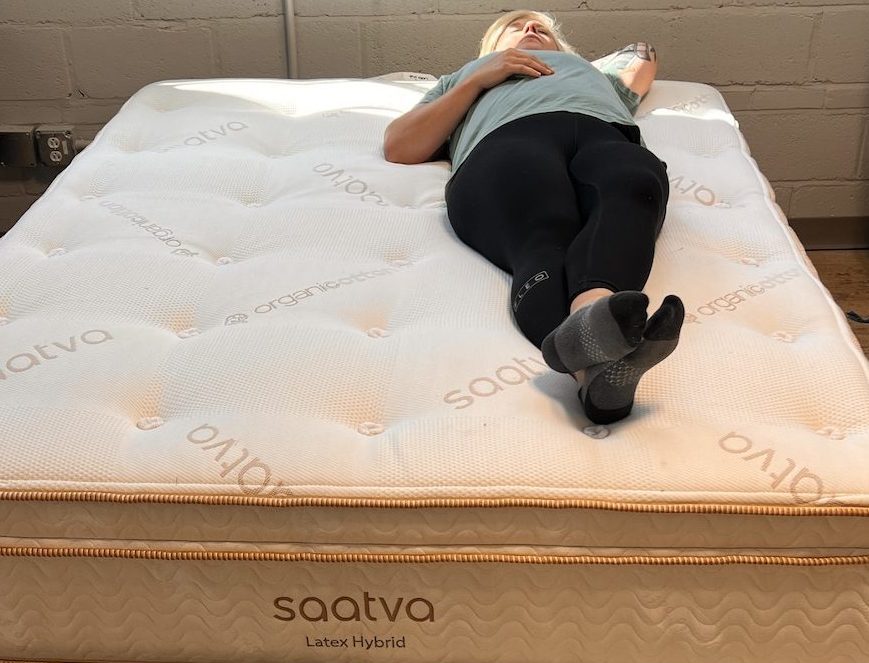Have you been shopping for a new mattress and are feeling overwhelmed? With so many types of mattresses, selecting the right one could feel like a daunting task.
One type that is rising in popularity is the latex mattress. These beds can be pricier than other types, but their benefits, durability, and comfort can make them worth the investment.
While latex mattresses are a great option, they are not all the same.
Understanding latex density and how it affects the properties of the mattress can help you determine which latex bed is right for you.
What Is Latex Density?
Latex has become a favored material when it comes to helping enhance durability and performance in mattresses. The density of latex rubber in a bed directly influences the bed’s cost, performance, and durability.
You can find the latex density in a mattress by calculating the pounds per cubic foot, also known as PCF. Depending on this PCF number, the bed will fall into one of three categories: low-density, medium-density, or high-density.
Since each density category has its own unique set of pros and cons, knowing the latex density in a mattress is an important factor to recognize.
How Is Latex Density Measured?
As mentioned above, the latex rubber density is measured using a mathematical formula to determine the pounds per cubic foot (PCF). The formula involves taking the object’s weight and dividing it by its total overall volume, and the resulting number is the PCF. For example, if a latex mattress weighs 100 pounds and measures 25 cubic feet, the result would be 4 PCF (100 divided by 25 equals 4).
The good news is you probably won’t have to figure this out on your own; most mattress manufacturers will list the materials used and the density (in PCF) on their websites. And if they don’t, you can ask their customer service reps.
In this chart you will see how latex’s density stacks up against memory foam and poly foam.
| Material | Low Density | Medium Density | High Density |
| Latex vs. Memory Foam | <4.3 PCF vs. <3 PCF | 4.3-5.3 PCF vs. 3-5 PCF | >5.3 PCF vs. >5 PCF |
| Latex vs. Poly Foam | <4.3 PCF vs. <1.5 PCF | 4.3-5.3 PCF vs. 1.5-1.7 PCF | >5.3 PC vs. >1.7 PCF |
How Latex Density Affects Mattress Performance
- Durability – Latex mattresses are very durable. Choosing a mattress with a high density of latex ensures maximum durability as these beds have one of the longest lifespans of at least eight years. However, even beds with a low latex density tend to last longer than other products, such as memory foam.
- Conforming – A mattress that conforms and supports your body is important when it comes to the comfort of your bed. A mattress with a low latex density may not conform as well. If you prefer a deeper cradle from your bed, consider choosing a high-density latex mattress.
- Pain/pressure relief – A low-density bed could provide sufficient support for those who experience slight aches and pains. However, people with chronic pain or those who want maximum support should opt for higher-density mattresses. These mattresses provide the most support for pain and pressure relief. Read about mattresses for pressure relief here.
- Temperature neutrality – Low-density beds are the optimal choice for keeping you cooler at night. Because they offer better air circulation, your body heat is less likely to get trapped. While low-density latex beds are best for cooler sleeping, even high-density latex mattresses are cooler than other foams.
- Sex – Low-density latex mattresses are more responsive than foam, making them better for sex. Also, sleeping with a partner means extra body heat, but as mentioned, low-density latex can help alleviate this. Conversely, since high-density latex lacks better air circulation and tends to be less responsive, it rates lower for sex. Explore our picks for the best beds for sex here.
- Motion isolation- Low-density latex mattresses do not rate well for absorbing motion transfer because of their responsive nature. While medium density doesn’t work as well as memory foam, it is still a decent option. However, for results similar to memory foam, a high-density latex bed is recommended.
- Odor potential- If you are sensitive to odors, you may want to consider a low-density latex bed. These beds will often have a rubbery smell when new, but this tends to fade quickly. On the other hand, high-density latex beds have been known to have a smell that can be pungent and persistent.
- Mattress weight – While the weight of latex mattresses varies depending on the density, they will all weigh much more than other foam options. Low-density latex options weigh the least, ranging from 90-105 pounds, while high-density latex weighs the most at around 110-125 pounds.
- Average price- Overall, latex mattresses are more expensive than other beds. As you can imagine, the higher the latex density, the higher the cost. Therefore, a low-density option will be the most budget-friendly.
Check Out Our Guide: Best Latex Mattress

Difference Between Density, Firmness, and ILD
Density and firmness ratings, along with latex ILD charts and guides, are all used when describing mattresses.
Density
Latex density is calculated by a mathematical formula. This is a way to gauge how firm a mattress feels; higher densities indicate a firmer feel. Mattresses often have multiple layers consisting of different densities, which can affect features such as responsiveness and temperature regulation. Mattresses made with lower density latex tend to be cooler because it has more air pockets that allow for better airflow.
Firmness
A mattress’s firmness is a more subjective measurement than density. We have a firmness scale that uses ratings of 1-10, with ten being the firmest. When determining a latex mattress’s firmness, we consider the density of the layers, but we also take a more hands on approach and lie on the bed in various sleep positions. This helps us determine how firm the bed will feel to most sleepers.
Indentation Load Deflection
The indentation load deflection (ILD) is another way to assign a firmness rating. The ILD is found by placing a 1-foot diameter disc on material 4 inches thick and then compressing. The number that it takes for 25 percent compression is referred to as the ILD rating.
Read More: What is ILD – Indentation Load Deflection?
What Kind of Latex Does Your Bed Have?
There are two main types of latex materials used: natural and synthetic. Blended latex uses both natural and synthetic.

Natural Latex
Natural latex is made mostly from the extract of rubber trees and is a great eco-friendly option.1 The Global Organic Latex Seal (GOLS) certifies that the latex is at least 95 percent natural. However, this means that 5 percent may contain other non-organic fillers.
Synthetic Latex
Synthetic latex is made mostly from petrochemicals. While this creates a similar density to organic latex, it may trap body heat more and is typically less durable.
Blended Latex
Blended latex has both natural and synthetic latex, but the ratio may vary. The general rule states that blended latex should feature at least 30 percent natural latex, or it could be labeled as synthetic. You may come across some brands calling blended latex natural, which is misleading because the blend also features synthetic components.
How to Choose the Right Latex Density?
To choose the right latex density for your new mattress, you’ll also need to consider your sleeping position and body weight.
Sleeping positions are categorized as back, side, stomach, and combination. Weight categories include lightweight sleepers (130 pounds or less), average weight sleepers (130-230 pounds), and heavyweight sleepers (230 pounds or more).
Lightweight sleepers will most likely find sufficient support with a low to medium-density bed, while heavyweight sleepers should consider a high-density mattress for full support. Whatever bed you choose, make sure it supports your body as needed.
More Info: Mattresses That Don’t Sag
Frequently Asked Questions
How does latex density affect the layers of your mattress?
Latex mattresses usually have two to five layers. The upper layers are less dense to offer comfort and some sinkage for relieving pressure points. The middle layers should be medium-to-high density, while the bottom layer should be the highest density to support and stabilize the upper layers. Although this is a common layout, some brands may make adjustments based on their research and technologies.
How does latex density compare with other foam types?
Latex is often compared to memory foam. Because memory foam softens when exposed to heat, the density could shift. Memory foam is generally a denser foam than standard poly foam, so it’s more durable but also prone to trapping heat. However, some memory foams have an open cell construction, which is a way to reduce heat, but this also lightens the density. Some poly foams are made to look and feel like memory foam or latex. Although these mattresses are significantly more affordable, they’re also less durable than all-latex beds.
Read More: Latex vs. Memory Foam
Do high density mattresses sleep hot?
No, high-density latex mattresses don’t sleep hot. That being said, they won’t be as cool as a low-density option. The only case in which a high-density latex mattress could sleep hot would be if it has a higher profile than 10 inches. The reason for this is that these beds may allow more sinkage, which could result in some heat build-up. Latex mattresses are breathable and often recommended for hot sleepers since they’re naturally more temperature-neutral than memory foam. Manufacturers may also implement breathable fabrics like cotton into their mattress covers to enhance the cooling effects of latex beds.
To Wrap It Up
Latex beds are an excellent option for someone seeking a new mattress. Their durability, ability to be eco-friendly, and exceptional cooling properties are just a few of the reasons for their growing popularity.
Although they may be a bigger purchase up front, it’s also a smart financial investment since they should last you a long time. Understanding the different latex density levels and the properties of each will ensure you choose the right density for your specific needs.
Once you choose your perfect latex mattress, you can rest easy and know it will support you for years to come.
The Advisor Says
If you want a firmer bed check out those that use high density latex, but remember this may make it sleep warmer than those made with lower density latex.

Katie Harris
Content Writer
About Author
Katie writes content at Sleep Advisor, where she has finally found people who appreciate her true passion for sleep. Based in Austin, Texas, she graduated with a degree in Communications and enjoys combining creativity with research to improve the world’s sleep, starting with her sleepwalking husband.
References:
- Gent, Alan N., “Tapping and coagulation”., Encyclopedia Britannica. Webpage accessed October 20, 2024.
